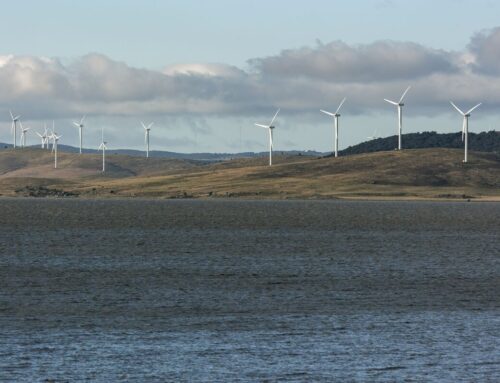EPA energy regulation rollbacks supporting Wisconsin businesses threaten renewable energy,
April 8, 2025
The U.S. Environmental Protection Agency’s Administrator Lee Zeldin announced 31 environmental regulation rollbacks March 12. Zeldin said these rollbacks are aimed to lower the cost of living for American families by making it more affordable to purchase cars, heat one’s home and conduct businesses.
But professors Gregory Nemet at the La Follette School of Public Affairs and Tracey Holloway in the Nelson Institute for Environmental Studies feel these rollbacks will not have their intended effect regarding businesses and public health.
“I disagree that we’re actually going to save [people] money by helping them or making them burn fossil fuels,” Nemet said.
Regarding businesses, a major focus of these rollbacks relates to the U.S. energy sector. Notably, they call for the reevaluation of the Biden administration’s “Clean Power Plant Plan 2.0,” which sought to limit carbon pollution. This plan aimed to reduce 90% of coal-fired plants’ carbon emissions in the next decade.
Now, under the Trump administration, the EPA has raised concerns around these goals. The organization claims the Clean Power Plant Plan 2.0 would place an unreasonable burden on gas and coal power plants and would cost $15 billion over the next two decades. Ultimately, the deregulation of carbon emission standards may lessen expenses for businesses but will allow greater carbon pollution.
On a national level, Republican congress members applauded the announcement. They state American energy businesses will thrive as a result of these rollbacks, according the EPA. In past years, the National Association of Manufacturers estimated adherence to federal regulations cost manufacturers around $3 trillion. Furthermore, some industry professionals — such as those in the Fabricators and Manufacturers Association — praised the announcement, asserting the rollbacks will relieve the burdens of environmental regulations.
For Wisconsin, deregulation may allow energy companies to keep pace with the state’s increasing energy demands. This need is partly due to concerns surrounding the reliability of the regional grid and the strain AI centers pose, according to the Wisconsin Energy Institute. Currently, Wisconsin is being considered for the development of three AI data centers, emphasizing an expected increase in the state’s energy needs.
In response to this demand increase, some state energy companies have delayed shutting down their coal power plants. For example, Alliant Energy announced they would close down its 400-megawatt Edgewater coal plant in Sheboygan this year and its Columbia Energy Center near Portage in 2026, according to Wisconsin Public Radio.
Now, Edgewater will continue using coal until 2028 and the Columbia center will convert to natural gas and operate until 2029. Essentially, the EPA’s rollbacks have the potential to weaken incentives for energy companies to transition away from non-renewable energy sources, Nemet said.
“I think that [green energy sources are] where the opportunities are,” Nemet said. “Everyone around the world sees it and is chasing it, so to say that we’re going to not compete just goes backwards into a time where it was all about fossil fuels. I don’t see how that supports jobs or supports people’s incomes or creates industries of the future.”
There are many alternatives to the use of fossil fuels, such as wind, solar, biomass, geothermal and nuclear energy, Nemet said. These forms of energy are increasingly becoming more affordable. While green energy may require an upfront investment, in the long-term, it saves individual consumers more than the continued use of fossil fuels.
This is partly due to the lack of price volatility of renewable energy sources. Fossil fuels are inherently connected to the price of oil, which is out of the country’s control and rather significantly dependent on the Organization of Petroleum Exporting Countries, according to the U.S. Energy Information Administration.
An investment in renewable energy may also protect Wisconsinites from dire health consequences, which are threatened by the EPA’s rollbacks, Holloway said. Specifically, the EPA announced the reconsideration of the PM 2.5 National Air Quality Standards for Particulate Matter, a part of the Clean Air Act.
“[PM 2.5] is really considered public enemy number one for human health,” Holloway said. “Almost anything bad with your health gets worse with PM 2.5.”
PM 2.5 refers to particulate matter with a diameter of 2.5 micrometers and smaller, according to the EPA. It is a mixture of solid particles and liquid droplets. They are created when power plants, industries and vehicles pollute the air with sulfur dioxide and nitrogen oxides, which then undergo chemical reactions in the atmosphere. PM 2.5 is linked to decreased lung function, nonfatal heart attacks, premature death in certain groups and more.
Notably, Black and brown communities in Wisconsin face a disproportionate amount of these health consequences. In 2022, the state ranked third worst in the country for racial disparities in exposure to harmful air pollution, according to a report from Clean Wisconsin.
Holloway said as a result of the Clean Air Act standards, air quality standards have gotten tighter and tighter, ultimately creating a cycle of promoting clean air. For the state, PM levels have been declining and the air quality has seen significant improvement, according to the Wisconsin Department of Natural Resources. The EPA’s reconsideration of PM 2.5 regulations weakens these standards, which may interfere with the progression of air quality.
Furthermore, this announcement marks another way Black and brown communities have been targeted, Holloway said. A month before the announcement, the EPA had removed an environmental justice mapping screening tool called EJScreen from their website, according to the Environmental Data and Governance Initiative.
Now, this deregulation action calls for the termination of the Environmental Justice and DEI arms of the EPA. Essentially, the current administration has made clear its denouncement of environmental justice efforts, Holloway said. This signifies a shift away from equity concerns to the prioritization of economic affairs.
Zeldin said the reconsideration of air quality standards allows the EPA to unleash an age of America’s economic prosperity. But, Holloway said that economic expansion and environmental regulations may build off each other.
“I get this idea that industry and jobs versus the environment is a false dichotomy, which is not to say that individual industries face daunting environmental challenges,” Holloway said. “… But, I think if you’re looking at this from a broad brush, U.S. wide perspective, I think that it’s very important to note that many of these regulations are job creators.”
Search
RECENT PRESS RELEASES
Related Post




